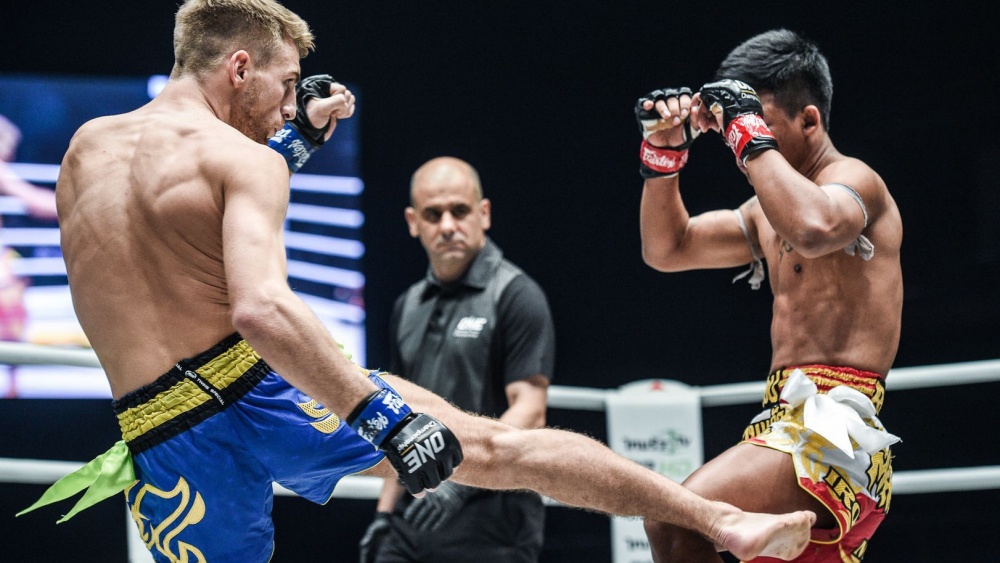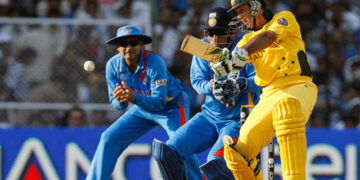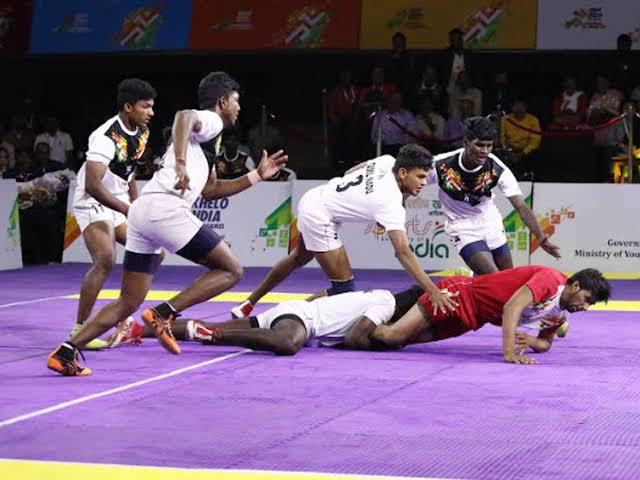
Summary
In Muay Thai, every strike has an answer. For low kicks and body kicks, the answer is the check. This simple yet crucial move can change the flow of a fight, turning an opponent’s best weapon into a vulnerability.
A well-timed check not only prevents damage but can also swing momentum instantly. Many fighters learn the hard way by just absorbing the kicks, which results in them losing out in later rounds.
Checking kicks is one of the most fundamental defensive skills in Muay Thai. A proper check can block powerful roundhouse kicks, protect the body and legs, and even discourage opponents from throwing them altogether. This article breaks down how to check kicks correctly, why it matters in Muay Thai, and how to build confidence in this essential defensive skill.
What Is A Check?
A check is a defensive action that uses the shin to block an incoming kick. When performed correctly, the defender lifts their leg, turning the shin outward at an angle to meet the opponent’s kick. The key is to time it so that the attacking shin connects with the harder part of the defender’s shin or knee.
This move protects the thigh and body while maintaining balance and readiness for counterattacks.
Why Checking Kicks Matters
Unchecked kicks can cause serious damage over time. Fighters who absorb too many low kicks often lose movement and stability, making them easy targets. By checking effectively, fighters protect their mobility and reduce their opponent’s confidence.
In Muay Thai, control and endurance often decide the outcome. A good check does both: it conserves energy and sends a clear message that the opponent’s main weapon will not work.
How To Check
- Stance And Balance: Begin in a solid Muay Thai stance with your weight evenly distributed. Always stay light enough on your feet to lift either leg quickly.
- Timing And Lift: As the opponent’s kick comes, lift your lead leg while keeping your guard high. Do not raise the leg straight upward; instead, angle the shin outward slightly.
- Turn The Hip: Rotate your hip slightly to ensure that your shin meets the kick at a strong angle. This distributes the impact and prevents your leg from folding backward.
- Land Firmly: After the check, return the leg quickly to your stance. Never leave it hanging, as that creates openings for follow-up strikes.
Common Mistakes To Avoid
- Lifting The Leg Too Late: Timing is crucial; a late check still allows the kick to land.
- Turning The Hips Too Little: A weak angle means absorbing the kick instead of blocking it.
- Leaning Backward: This disrupts balance and prevents effective counters.
- Dropping The Hands: Always keep the guard high during a check to protect from follow-up punches.
Turning Defense Into Offense
A check does more than just block an oncoming kick; it sets up counters. Many experienced fighters use the rebound from a check to fire back with punches or low kicks of their own.
For example, after checking a kick, a quick right cross or inside low kick can catch the opponent off guard. This turns the defensive move into a rhythm-breaking weapon that keeps opponents guessing.
Training Drills For Better Checks
- Partner Drills: Have your partner throw light kicks while you practice checking with proper timing and posture.
- Pad Drills: Use a coach’s shin pad to simulate incoming kicks. Focus on timing and quick resets.
- Shadowboxing Drills: Practice lifting your leg and turning your hip while visualizing incoming kicks.
- Sparring Application: Use live sparring to build timing confidence. Start slow and increase speed as you improve.
FAQs On Checking Kicks
Q: What Is A Check In Muay Thai?
A: A check is a defensive move that uses the shin to block an opponent’s kick, preventing damage to the thigh or body.
Q: How Do You Properly Check A Low Kick?
A: Lift your lead leg, turn your shin outward, and meet the kick with the upper part of your shin or knee while keeping your guard high.
Q: Can Checking Kicks Hurt Your Opponent?
A: Yes. A well-timed check can cause pain or bruising to the attacker’s shin, discouraging them from throwing more kicks.
Q: How Do I Know If My Timing Is Right?
A: If you feel the impact on your shin rather than your thigh and stay balanced afterward, your timing is correct.
Q: Is Checking Safe For Beginners?
A: Yes. With proper instruction and controlled practice, beginners can safely develop the skill to check kicks effectively.
Conclusion
In Muay Thai, checking kicks separates experienced fighters from beginners. It is not just about blocking but about control. Control over timing, balance, and the pace of the fight. A fighter who can check effectively not only protects themselves but also gains a mental edge, forcing their opponent to rethink every strike.
Mastering the check is about discipline and repetition. With practice, it becomes second nature, forming the backbone of smart, sustainable Muay Thai defense.
You may also like:
The Power Of The Leg Kick: Why Low Kicks Are Often The Silent Fight Breakers
Summary Sparring isn’t just for fighters who step into the ring. For hobbyists, it’s one of the best ways to truly understand Muay Thai. It teaches timing, defense, and strategy in a way that pad…
Low leg kicks are one of the most under-appreciated weapons in striking arts. They quietly erode an opponent’s mobility, set the pace, and often serve as fight finishers. In Muay Thai, kickboxing, and MMA, a…
Muay Thai is often called the art of eight limbs, combining punches, kicks, elbows, and knees into a complete striking system. Among these weapons, the knee is one of the most powerful and effective tools,…
In combat sports, the way a fighter stands can change everything about how a match unfolds. Stance determines balance, power, and angles of attack. Among the many stances, the southpaw stance is often described as…
In Muay Thai, different fighters develop distinct styles based on their strengths and strategies. Muay Khao refers to the knee-fighting style, one of the most dominant approaches in the sport. A Muay Khao fighter uses…
Starting Muay Thai is exciting, but walking into your first class can feel intimidating if you don’t know what to bring. Gloves, wraps, shorts, shin guards… do you really need them all on day one?…
Summary Aung La “The Burmese Python” N Sang is one of Asia’s most beloved mixed martial artists and a symbol of national pride for Myanmar. From humble beginnings to becoming a two-division ONE Championship World…
Raising children with strong values is every parent’s goal. Beyond academics and extracurriculars, many parents look for activities that help their children grow into responsible, disciplined, and dependable individuals. One of the most effective ways…
Summary Martial arts training is not only about building strength or preparing for competition. It is also a journey toward inner calm. Through movement, controlled breathing, and focus, martial arts help reduce stress, improve mindfulness,…
Summary The speed bag is one of the most iconic tools in boxing gyms, but it’s often misunderstood. More than just a flashy skill, it develops rhythm, timing, hand-eye coordination, and endurance, which are all…
Mark Kerr, nicknamed “The Smashing Machine,” was one of the most dominant forces in the early days of mixed martial arts. A decorated wrestler, submission grappler, and tournament champion, he helped shape the foundation of…
In mixed martial arts (MMA), striking often gets the spotlight, but grappling quietly serves as one of the most important foundations of the sport. Fighters with strong grappling backgrounds control where the fight takes place,…


![[WATCH] IND vs SA 2025: Rohit Sharma hurls abuse in excitement after Virat Kohli hits hundred; video goes viral](https://lbsports88.com/wp-content/uploads/2025/11/watch-ind-vs-sa-2025-rohit-sharma-hurls-abuse-in-excitement-after-virat-kohli-hits-hundred-video-goes-viral-360x180.jpg)





























![[WATCH] IND vs SA 2025: Rohit Sharma hurls abuse in excitement after Virat Kohli hits hundred; video goes viral](https://lbsports88.com/wp-content/uploads/2025/11/watch-ind-vs-sa-2025-rohit-sharma-hurls-abuse-in-excitement-after-virat-kohli-hits-hundred-video-goes-viral-120x86.jpg)

